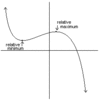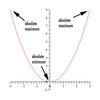Maxima and Minima Flashcards
Relative/Local maximum or minimum
Means that the curve has a horizontal tangent line at that piont, but it is not the highest or lowest value that the function attains.

Absolute maximum or minimum
Occurs either at an artificial point or an end point.

If a function has a critical value at x=c, then how do you tell whether it is a relative maximum or a relative minimum?
Relative maximum if ƒ”(c) < 0
Relative minimum if ƒ”(c) > 0
To determine maximum or minimum,
The technique is always the same:
(a) Take the derviative of the equation.
(b) Set it equal to zero – critical points.
(c) Use the second derivative test:
- (–) = maximum
- (+) = minimum.
How do you know when a curve is rising, falling, or at a critical point?
When ƒ’(x) > 0, the curve is rising.
When ƒ’(x) < 0, the curve is falling.
When ƒ’(x) = 0, the curve is at a critical point.
How do you know when the curve is concave up, concave down, or at a point of inflection?
When ƒ”(x) > 0, the curve is concave up.
When ƒ”(x) < 0, the curve is concave down.
When ƒ”(x) = 0, the curve is at a point of inflection.
How do you find the y-coordinates of a critical point?
Plug the x-value of each critcal point into the original equation.
Finding a cusp
limx→c- ƒ(x) = ∓∞ and limx→c+ ƒ(x) = ±∞,
and ƒ(x) is continuous at x=c,
then the curve has a cusp at that point.

Finding a horizontal asymptote
A line y = c is a horizontal asymptote of the graph of y = ƒ(x) if:
limx→∞ ƒ(x) = c or if limx→-∞ ƒ(x) = c
Finding a vertical asymptote
A line x = k is a vertical asymptote of the graph of y = ƒ(x) if:
limx→k<span>+</span> ƒ(x) = ±∞ or if limx→k- ƒ(x) = ±∞


